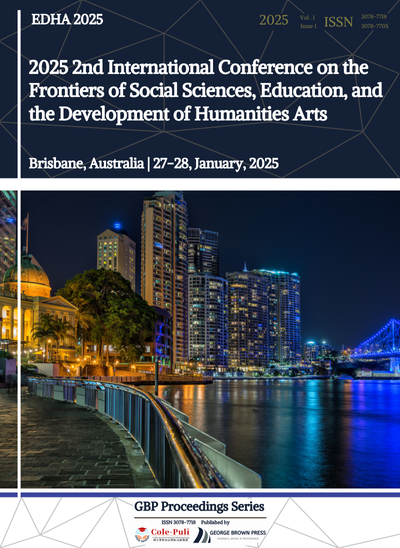A Study on the Application of Discourse Analysis Theory in English Reading Teaching in Senior High School
DOI:
https://doi.org/10.71222/rm9dxf89Keywords:
discourse analysis theory, English reading teaching, senior high school, reading comprehension, student engagementAbstract
Reading is not only one of the purposes of English teaching, but also an important way of English learning. Reading plays an essential role in student language input, and it occupies a large proportion at different kinds of English tests. However, in the traditional reading classes, the key point is to explain language points and ignores to develop students’ ability of analyzing discourse. Thus, students have little interest in reading, and the lack of knowledge of discourse, causing students lack of confidence when doing reading. The English Curriculum Standards for Senior High School requires students to deepen the understanding of discourse, attach great importance to the analysis of discourse, and improve their reading ability. Therefore, this study aims at discovering the current situation of senior high school students’ discourse analysis ability and figure out the factors that prevent teachers from applying discourse analysis theory in English reading teaching. The research participants are 110 students and 2 English teachers in senior two in Kunming. And the research instruments include questionnaire interview and classroom observation. Questionnaire is used to know the change of students’ discourse awareness. Based on data analysis, the researcher has three main findings. Firstly, students’ discourse analysis abilities on both macro and micro levels are only moderately developed and relatively low. They struggle with aspects such as genre recognition, background knowledge utilization, and coherence understanding, indicating a lack of proficient discourse consciousness. Secondly, although teachers are making efforts to apply discourse analysis theory in English reading teaching, their teaching objectives and methods vary significantly. Thirdly, teachers’ understanding of discourse analysis theory (DAT) is not unified. Their different interpretations and approaches result in an unsystematic application of DAT in teaching practice.
References
1. A. Hakim and S. Wahyuni, “A critical review: Technology as learning media in teaching reading,” J-SHMIC J. Engl. Acad., vol. 11, no. 1, pp. 77–83, 2024, doi: 10.25299/jshmic.2024.vol11(1).15830.
2. J. T. Li, F. Tong, B. J. Irby, R. Lara-Alecio, and H. Rivera, “The effects of four instructional strategies on English learners’ English reading comprehension: A meta-analysis,” Lang. Teach. Res., vol. 28, no. 1, pp. 231–252, 2024, doi: 10.1177/1362168821994133.
3. S. Em et al., “Encouraging English language reading in Cambodia: A case study of Takeo provincial higher educational in-stitutions,” J. Gen. Educ. Humanit., vol. 3, no. 2, pp. 85–102, 2024, doi: 10.58421/gehu.v3i2.205.
4. W. Tian, “Exploration of high school English reading teaching strategies guided by the activity-based approach to English learning,” Int. J. Educ. Soc. Dev., vol. 2, no. 1, pp. 66–73, 2025, doi:10.54097/6pqwyq91.
5. W. Xu and J. Knijnik, “English as a world opener in Chinese universities: Fostering interculturally aware communities of learners in the English reading classroom,” Pedagogy Cult. Soc., vol. 32, no. 5, pp. 1343–1359, 2024, doi: 10.1080/14681366.2023.2174171.
6. Y.-S. G. Kim et al., “The science of teaching reading is incomplete without the science of writing: A randomized control trial of integrated teaching of reading and writing, ” Sci. Stud. Read., vol. 29, no. 1, pp. 32-54, 2025, doi: 10.1080/10888438.2024.2380272.
7. G. N. Rios et al., “Methodological strategies and techniques implemented by teachers in the teaching-learning process of Eng-lish in Spanish-speaking students,” Proc. Comput. Sci., vol. 231, pp. 508–513, 2024, doi: 10.1016/j.procs.2023.12.242.
8. P. Suárez-Coalla et al., “English reading performance by Spanish speaking children: A phonologically or semantically medi-ated pathway?,” Read. Writ., vol. 37, no. 10, pp. 2831–2857, 2024, doi:10.1007/s11145-023-10497-1.
9. H. Crompton, A. Edmett, N. Ichaporia, and D. Burke, “AI and English language teaching: Affordances and challenges,” Br. J. Educ. Technol., vol. 55, no. 6, pp. 2503–2529, 2024, doi: 10.1111/bjet.13460.
10. A. Mekuria, E. W. Bushisho, and H. Wubshet, “The effects of reading strategy training on students’ reading strategy use and critical reading ability in EFL reading classes,” Cogent Educ., vol. 11, no. 1, p. 2310444, 2024, doi: 10.1080/2331186X.2024.2310444.
11. T. Cremin et al., “Widening teachers' reading repertoires: Moving beyond a popular childhood canon,” Read. Teach., vol. 77, no. 6, pp. 833–841, 2024, doi: 10.1002/trtr.2294.










